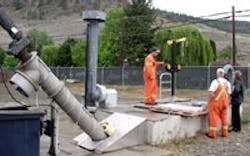WWTP Upgrade Cuts Headworks Maintenance By 75%
The city of Merritt, British Columbia, Canada, was in need of an upgrade for the town’s wastewater treatment plant. Luckily the upgrade happened, and it not only fixed the plant’s original problems, but also led to a 75% reduction in routine maintenance time for screening equipment.
The 1.5 million gallon per day (240 m3/h) facility in Merritt was commissioned in 1963 as a secondary treatment plant with tertiary treatment via ferrous chloride-induced phosphorous extraction. The plant has been through six expansions—the latest completed in 2000. It currently serves about 3,500 connections; 95% are residential and the rest are saw mills, planer mills and light industrial sites.
Upgrading the system
The upgraded system, an Auger Monster fine screen, removes unwanted plastics and trash and aids in the restoration of optimal BOD levels. With key components made from stainless steel, plant managers expect this system to have a significantly extended service life.
The Auger Monster is manufactured by JWC Environmental of Costa Mesa, Calif., and incorporates a spiral lifting screw with patented Muffin Monster grinding technology. The system combines the benefits of a fine screen with the high-flow capability of a bar screen, making it easier to remove unwanted solids from the wastewater channel. As solids are conveyed, dual spray wash zones liquefy the soft organics so they can pass through the perforated screen and return to the treatment process. The remaining trash is dewatered and compacted before dropped into a dumpster.
Shawn Boven, Merritt’s public works manager, explained the thinking behind the equipment change. “Once it was confirmed that we were upgrading the existing facility instead of building on an alternate site, the Auger upgrade was first on the list,” Boven said. “Any time there is an opportunity to free up operator time and improve the overall operational process, it should be taken. This was one of those times.”
The plant’s former senior operator, Ed Morris, recalls the installation of the JWC screening equipment, and the benefits it provided. “We had a 6-in. (150 mm) microscreen process to remove biosolids during the primary treatment stage which we trucked to the city’s permitted landfill,” Morris said. “We joined the regional district landfill when the city decommissioned their site in 1996. Then they shut down their septage lagoon in 1998 and no longer took screenings with biological (fecal) content. So we had to put something in the plant to remove the screenings.”
Positive results
“Once installed, we saw immediate results through improved biomass and we undertook a six month optimization of our entire process,” said Morris. “With BOD now ranging from 150 to 250 mg/L, typically at 200 mg/L, we started running more smoothly and less subject to stress or upset to the biological process.”
Morris also noted that input surges from rain and melt are also less of a problem, and there is less clogging of pumps and other equipment by textile, plastic and rubber solid waste, because those items are now removed by the new system. The plant was also able to eliminate its microscreen, as well as a compactor used for dewatering screenings.
Most importantly, the unique process of grinding prior to solids separation removes nearly all soft organics (fecal) from discharged screenings, thus reducing odors and landfill costs. Of course, nearby residents appreciate this.
Cliff Seth is a professional writer. For more questions regarding JWC, please email [email protected] or call 949-833-3888.
